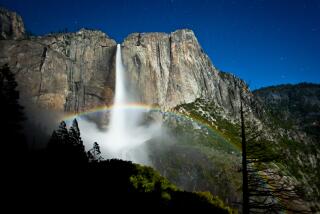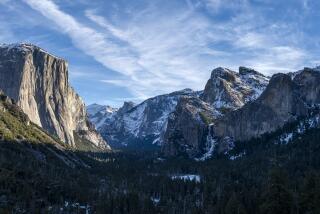So aptly named
Yosemite Valley, Lembert Dome and Crazy Mule Gulch. You’ve climbed them, traversed them and forded them, but you probably didn’t know their pedigree.
“Yosemite: Place Names” by Peter Browning is an encyclopedic listing of who named what and when, peppered with quotations and stories of events that gave rise to the names.
Here’s a sampling:
Bridalveil Fall
Yosemite Valley
[James Mason] Hutchings claimed that he suggested the name for the falls, above, on his first visit to Yosemite, in 1855. “Is it not as graceful, and as beautiful, as the veil of a bride?”
Yosemite Valley
Yosemite National Park
Named in 1851 by the Mariposa Battalion, which was camped in Yosemite Valley near Bridalveil Fall. Sitting around a campfire, after a period of “coarse jokes and ready repartee,” the men followed the lead of the detachment’s surgeon, who proposed naming the Valley for the Indians they were pursuing.
Crazy Mule Gulch
Matterhorn Peak
Named for a 1905 incident in which a hot, tired mule chose to leave the trail and slide down a rock chute to speed its descent.
Hodgdon Meadow
Ackerson Mountain
Named for Jeremiah Hodgdon, who settled in the area in 1865. Hodgdon housed travelers, but wasn’t known for his cooking or hospitality. He crammed as many as five in a room and fed them “junks of beef floating in bowls of fat, junks of ham, ditto ... potatoes as hard as bullets,” set out in a nasty, unventiliated room, dimly lit by two reeking kerosene lamps.
Lembert Dome
Tioga Pass
Named for John Baptist Lembert, who lived there in the late 1800s, raised goats and built an 8-by-10-foot cabin directly on top of a spring, so that water bubbled up in the center of the cabin.
Union Point
Yosemite Valley, Half Dome
Named around 1871 for an Irishman living there in a makeshift wigwam, from the top of which waved an American flag.
Smoky Jack
in Tamarack Flat
Formerly a campground: named for John Muir’s encounter in 1869 with a sheep herder who lived on beans. Smoky Jack filled his pockets with cooked beans, so that his overalls and boots became saturated with bean juice, which created a paste that attracted vegetation and fibers that “grew to have a rich geological and biological significance.”
-- Janet Cromley
More to Read
Sign up for The Wild
We’ll help you find the best places to hike, bike and run, as well as the perfect silent spots for meditation and yoga.
You may occasionally receive promotional content from the Los Angeles Times.






